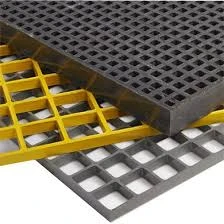loading...
- No. 9, Xingyuan South Street, Dongwaihuan Road, Zaoqiang County, Hengshui, Hebei, China
- admin@zjcomposites.com
- +86 15097380338
- Welcome to visit our website!
Understanding the Benefits and Applications of FRP Treads in Various Industries
Understanding FRP Treads A Comprehensive Overview
Fiber Reinforced Polymer (FRP) treads have emerged as a revolutionary solution in various industries, offering a versatile alternative to traditional materials such as wood or metal. FRP is a composite material made from a polymer matrix reinforced with fibrous materials, which can include glass, carbon, or aramid fibers. This combination not only enhances the mechanical properties but also significantly improves durability and resistance to environmental factors.
Advantages of FRP Treads
One of the most significant benefits of FRP treads is their lightweight nature, which makes them easier to handle and install compared to heavier materials. This characteristic is particularly advantageous in construction and industrial settings, where reducing the weight of materials can lead to lower transportation costs and easier installation processes. Additionally, FRP treads are highly resistant to corrosion, making them ideal for environments where they are exposed to moisture, chemicals, or other corrosive substances. This durability translates into lower maintenance costs and a longer service life, which is an appealing factor for businesses looking to maximize their investments.
FRP treads also offer excellent slip resistance, an essential feature for safety in both industrial applications and public spaces. The surface can be engineered to provide optimal traction, reducing the risk of accidents in environments like factories, warehouses, and outdoor stairways. This safety feature is particularly crucial in areas where workers or the public frequently traverse, helping to prevent slips and falls.
Applications of FRP Treads
frp treads

The versatility of FRP treads allows for a wide range of applications across different sectors. In construction, they are often used for staircases, walkways, and platforms, providing a safe and durable surface for high-traffic areas. In the transportation sector, FRP treads can be found in vehicles, railways, and even marine applications, thanks to their lightweight and corrosion-resistant properties.
Industrial facilities, especially those that deal with harsh chemicals or outdoor elements, benefit greatly from FRP treads. The chemical resistance of FRP makes it a perfect choice for chemical processing plants, where spills and leaks are a standard risk. Furthermore, because FRP materials can be custom-molded, they can be designed to fit specific structural requirements or aesthetic preferences.
Environmental Impact
Another noteworthy advantage of FRP treads is their environmental performance. The manufacturing processes for FRP are relatively energy-efficient compared to traditional materials, and the lifespan of FRP products often means they need to be replaced less frequently, thereby reducing waste. Additionally, many manufacturers are now focusing on developing eco-friendly resins and recyclable fibers, further enhancing the sustainability of FRP products.
Conclusion
In summary, FRP treads represent a significant advancement in material technology, providing an array of benefits that can enhance safety, durability, and cost-effectiveness across various industries. Their lightweight nature, coupled with exceptional resistance to corrosion and slip, makes them an attractive option for applications in construction, transportation, and industrial settings. As the demand for durable and sustainable materials continues to grow, FRP treads are likely to play an increasingly vital role in shaping the future of construction and manufacturing practices. With their unique properties and versatile applications, they are truly a material for the modern age, catering to the needs of both businesses and society at large.
-
the-expansive-industrial-reign-of-frp-pressure-vesselsNewsAug.22,2025
-
manufacturing-premium-frp-square-pipes-for-global-wholesale-excellenceNewsAug.22,2025
-
strategic-applications-for-frp-grating-solutionsNewsAug.22,2025
-
material-science-forging-grp-water-tank-longevityNewsAug.22,2025
-
the-engineered-excellence-material-science-behind-frp-railing-systemsNewsAug.22,2025
-
how-digital-pultrusion-revolutionizes-frp-profile-wholesalingNewsAug.22,2025
-
The Rise of FRP Profiles: Strong, Lightweight, and Built to LastNewsJul.14,2025
